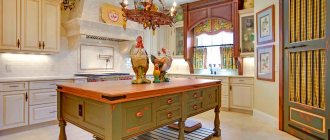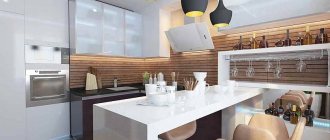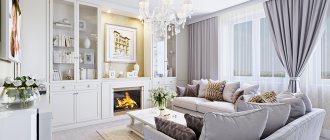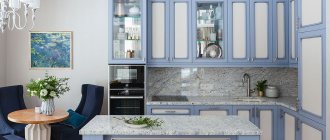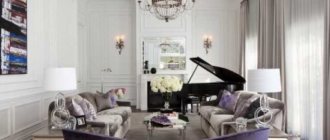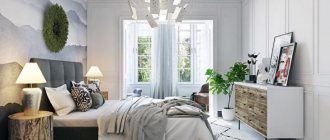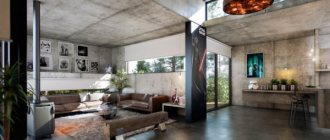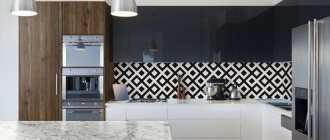Neoclassicism in the interior: simple and accessible - what it is, trends and nuances of style
Distinctive features of the style are:
- expensive appearance of the room;
- simplicity and conciseness;
- symmetry;
- natural motives;
- preference for natural materials.
Neoclassicism does not tolerate excess. When decorating the interior of an apartment, a sense of proportion and accuracy is important. The design necessarily uses classical elements: stucco, mirrors, etc., which adds luxury and sophistication to the atmosphere.
view album in new window
Neoclassical interiors are usually designed in spacious rooms. The luxury and respectability of the style is emphasized by high ceilings and large windows. When planning the interior, the principle of symmetry in the arrangement of furniture and decor is applied.
Advantages and disadvantages
Neoclassical kitchens in the interior of an apartment look ideal in the photo, but they have not only advantages, but also disadvantages.
Photo: Sergey Morgunov. Stylist: Evgenia Shuer. Author of the project: Masha Narbut, Vasily Chernov
Photo: Sergey Morgunov. Stylist: Evgenia Shuer. Author of the project: Masha Narbut, Vasily Chernov
Interior photo: Dmitry Livshits. Project author: Natalya Samoilova
Interior photo: Dmitry Livshits. Project author: Natalya Samoilova
Photo: Evgeny Luchin. Stylist: Irina Khromova Project author: Anastasia Sizova Project manager: Sergey Dudenko
Photo: Evgeny Luchin. Stylist: Irina Khromova Project author: Anastasia Sizova Project manager: Sergey Dudenko
Advantages
1. Functionality and ergonomics. Neoclassicism is not one of those styles that is only about “decoration”. This direction takes into account the main rules of ergonomics and focuses on functionality.
Photo: Dmitry Livshits. Author of the project: Tatyana Mironova, Andrey Kontorovsky
Photo: Dmitry Livshits. Author of the project: Tatyana Mironova, Andrey Kontorovsky
Photo: Instagram @iltesoro.online
Photo: Instagram @iltesoro.online
Photo: Evgeny Luchin. Stylist: Irina Khromova Project author: Anastasia Sizova Project manager: Sergey Dudenko
Photo: Evgeny Luchin. Stylist: Irina Khromova Project author: Anastasia Sizova Project manager: Sergey Dudenko
2. Harmony. The direction can be safely considered the “golden mean”: its laconicism is moderate, not brought to minimalism; it combines modern trends and classical techniques; he is open to various decorative trends, but does not accept exaggeration and excesses.
Photo: Sergey Ananyev. Project author: Ilya Shulgin, Kirill Kochetov
Photo: Sergey Ananyev. Project author: Ilya Shulgin, Kirill Kochetov
Photo: Instagram @estee_design
Photo: Instagram @estee_design
Photo: Dmitry Livshits. Author of the project: Tatyana Mironova, Andrey Kontorovsky
Photo: Dmitry Livshits. Author of the project: Tatyana Mironova, Andrey Kontorovsky
3. Solidity. Neoclassicism is not a budget style; a kitchen in this style looks solid and impressive.
Photo: Evgeniy Kulibaba. Designer: Anastasia Merzlyakova
Photo: Evgeniy Kulibaba. Designer: Anastasia Merzlyakova
Photo: Evgeny Luchin. Stylist: Irina Khromova Project author: Anastasia Sizova Project manager: Sergey Dudenko
Photo: Evgeny Luchin. Stylist: Irina Khromova Project author: Anastasia Sizova Project manager: Sergey Dudenko
Photo: Konstantin Dubovets. Project author: Natalya Nikiforova
Photo: Konstantin Dubovets. Project author: Natalya Nikiforova
4. Relevance. The direction is one of the most popular today.
Photo: Andrey Sorokin. Author of the project: Ekaterina Rebrova, Elena Povorova
Photo: Andrey Sorokin. Author of the project: Ekaterina Rebrova, Elena Povorova
Photo: Rositsa Pereslavtseva. Author of the project: Yana Volkova, Yuri Volkov
Photo: Rositsa Pereslavtseva. Author of the project: Yana Volkova, Yuri Volkov
Photo: Alexander Kamachkin. Architect: Marina Bocharova
Photo: Alexander Kamachkin. Architect: Marina Bocharova
5. Suitability for any type of housing. The style is suitable for decorating country houses and city apartments, spacious rooms and standard housing.
Photo: Dmitry Livshits. Author of the project: Tatyana Mironova, Andrey Kontorovsky
Photo: Dmitry Livshits. Author of the project: Tatyana Mironova, Andrey Kontorovsky
Photo: Mikhail Stepanov. Designer: Tatyana Boronina
Photo: Mikhail Stepanov. Designer: Tatyana Boronina
Photo: Evgeny Luchin. Project author: Maxim Prunkov, Alexander Korolev
Photo: Evgeny Luchin. Project author: Maxim Prunkov, Alexander Korolev
6. Flexibility. The style is loyal to the use of a wide variety of colors, allows for inclusions of other trends, and may have a slightly greater bias towards classics or modernity.
Photo: Andrey Sorokin. Author of the project: Ekaterina Rebrova, Elena Povorova
Photo: Andrey Sorokin. Author of the project: Ekaterina Rebrova, Elena Povorova
Photo: Rositsa Pereslavtseva. Author of the project: Yana Volkova, Yuri Volkov
Photo: Rositsa Pereslavtseva. Author of the project: Yana Volkova, Yuri Volkov
Photo: Instagram @estee_design
Photo: Instagram @estee_design
Photo: Andrey Sorokin. Author of the project: Ekaterina Rebrova, Elena Povorova
Photo: Andrey Sorokin. Author of the project: Ekaterina Rebrova, Elena Povorova
Neoclassical and classical styles in the interior: what are the differences
Neoclassicism took from classical interiors a penchant for using natural materials and decorative items. But the setting allows the use of modern parts, including a plasma TV. Natural materials can be replaced with high-quality imitation.
view album in new window
Neoclassical interiors are characterized by restraint and minimalism. Decor is used, but in limited quantities. Ceilings are usually left plain, but are emphasized with ornate cornices.
Neoclassical kitchen design: color solutions (with photos)
Kitchens designed according to neoclassical canons are characterized by restrained color schemes. Look at these photos.
You see, there are no sharp transitions, contrasts, diversity - everything is harmonious and precise. Preference is given to soft pastel colors.
Light shades in kitchen design - examples of neoclassical interiors
If you scroll through all the photos, you will notice that most neoclassical style kitchens are decorated in light colors. Milky, ivory, pale peach, gray - these shades perfectly convey the aristocracy and noble character of this trend. Even simple sets without decorative excesses in light colors look rich and respectable.
For a small kitchen, light shades are also an opportunity to visually enlarge and expand the space, making it lighter.
Here's another example of the design. Here the kitchen area does not exceed 14 square meters. meters, but this did not become an obstacle to creating a harmonious space in a neoclassical style.
Neoclassical in white? Why not? (+photo examples of kitchen design)
Pure white kitchens are rare. The snow-white color is perceived as cold, which is not entirely in the spirit of the neoclassical style. But if presented correctly, such a kitchen can become a real decoration of the home. Like in these photos.
If you place black accents, the white kitchen will become more expressive and interesting. However, dark elements must be used carefully, like strokes. For example, these could be shaped elements on the facades of furniture, handles, and parts of kitchen appliances.
You can add color to a white kitchen with a colored backsplash. Glossy tiles harmonize perfectly with mother-of-pearl decorative elements, which are often found in neoclassical style.
Neoclassical style: kitchen design in blue tones
This blue kitchen radiates warm energy.
It’s nice to be here, drink tea, cook. However, the abundance of blue in neoclassical style can create an oppressive feeling. It is advisable to dilute deep tones:
- white;
- ecru;
- caramel;
- blue;
- pale gray;
- dirty blue.
Beige color in kitchen design: neoclassical approach
Very often, beige is chosen as the main color for neoclassical kitchens. This design favorably emphasizes the style and looks luxurious. Here is an example of the interior. Look how harmoniously the beige set is complemented with a light marble countertop.
And here small splashes of turquoise have been added to the design.
Shade preferences in the interior of an apartment decorated in neoclassical style
Furnishings in the neoclassical style look expensive and elegant, largely due to the fact that only natural shades are used. The basis is a light color scheme. In this case, the ceiling is finished in the lightest shade, the floor in a dark one.
In neoclassicism, the following colors are relevant: beige, gray, white, golden, blue, brown.
view album in new window
For finishing you can use all shades of natural wood. Designers do not recommend mixing many colors. It is better if the main one is chosen and its shades are played out. Neoclassicism does not use bright colors.
Sofa seat
in the design of a neoclassical living room
Visual planning
. If you have chosen the style of a neoclassical living room for yourself, the designers definitely advise you to first draw up a plan, a project on which to “place” the furniture, with all dimensions. This will allow you to look at the situation from all sides and prevent you from changing your original idea of the chosen design.
Thus, a living room in a neoclassical style provides for the correct placement of furniture, according to the style, and the sofa certainly should not be in a draft. You should not place it on a line running from the window to the doorway - this can be easily tracked both on the floor plan of the room, and simply by visually drawing this conditional line.
The location of the sofa in the living room
. How to place the sofa correctly so that the living room in the neoclassical style meets all the canons of the genre? Next, we will present several options - each, depending on the tasks set, can change the interior itself.
1. The sofa can be placed, for example, diagonally across the door, opposite the TV - it invites you to sit down and relax.
2. Can also be placed near the doorway. A great option if you often receive guests in your home, and even overnight.
3. The neoclassical living room interior also includes the use of a corner sofa - it is optimal to place it in the far corner of the room, making it more spacious.
Finishing materials in neoclassicism
A distinctive feature of modern classics is that natural materials can coexist with plastic. Innovative technologies are used in the interiors. Artificial materials can be used for finishing, but they must accurately imitate the natural texture.
view album in new window
Walls
Neoclassical interior design depends on what the owner of the room wants to get as a result. Decorative plaster or painting is used to decorate the walls. Wallpapering is allowed, including those with strict geometric patterns.
view album in new window
Among the modern materials used in neoclassicism, metallized tiles are noted. Sometimes designers resort to decorating walls with mirror or glass panels. For the kitchen and bathroom you should choose marble tiles or porcelain tiles.
Ceiling and floor
The ceiling can be simple or multi-level. Paint is used for finishing. The interior of apartments in the neoclassical style provides a perfectly flat surface. Usually it is left white or made light beige. Tensile structures can be used in interiors. Matte or glossy surfaces can be used.
view album in new window
Multi-level ceilings are made using plasterboard. Installation of decorative elements on the surface is not recommended. However, non-standard lighting may be used.
Parquet boards or laminate are laid on the floor. A feature of neoclassicism is that there is no restriction on the use of artificial materials. The only condition is that they must be of high quality. For finishing it is recommended to take such types of wood as: oak, ash, rosewood, etc.
view album in new window
For finishing, parquet boards or laminate are used, which qualitatively imitate a wooden surface. In the kitchen, dining room, and hallway, the wooden floor can be replaced with porcelain stoneware or polished stone.
Windows and doors
Neoclassicism is ideal for spacious rooms. Owners of country houses are recommended to install panoramic windows. If the interior is being done in a city apartment, then wide window sills should be used.
view album in new window
Doors are installed from natural wood or veneer. Glass or stained glass inserts are allowed in the canvases. For the bedroom you should choose a solid closed door. The canvases may contain carved elements.
view album in new window
Finishes and materials
Neoclassicism is distinguished by certain facing materials.
Walls
Decorative plaster, such as Venetian or glossy and matte paint, is used for finishing. Additional details in the design of walls can be decor in the form of columns, arches and niches.
The photo shows a bedroom in a neoclassical style with walls covered in gray-golden wallpaper.
Wallpaper is chosen either in a single color or in canvases decorated with neutral patterns or wide stripes.
The photo shows the walls in the bathroom in the neoclassical style, tiled.
Floor
The style involves high-quality floor covering, for example, with various types of wood such as rosewood or oak. Ceramics that imitate wood will look no less harmonious. Neoclassical flooring has a luxurious and respectable look, which can be created perfectly with parquet or laminate.
An alternative to wood finishing is the use of porcelain stoneware or polished marble. This solution will especially complement the kitchen or hallway. A guest room, bedroom or dressing room can be decorated with carpet.
The photo shows the interior of a small living room with a floor decorated with brown parquet boards.
Ceiling
A good solution is a smooth ceiling plane in white tones, combined with the shade of the walls. To decorate the ceiling, it is appropriate to use wooden panels that divide the surface into equal rectangular parts or stucco molding in the form of cornices, baseboards, moldings or rosettes.
Doors
Interior paintings are distinguished by a strict symmetrical design and are made from expensive wood. Basically, neoclassicism is characterized by doors in light colors with the addition of gilded details, natural wood or mother-of-pearl shades.
The photo shows swinging white doors with glass inserts in a neoclassical interior.
It is possible to install panel doors decorated with various inserts, blind structures or panels supplemented with glass, stained glass or mirrors.
Modern furniture in neoclassical style
Interior items depend on the budget and taste preferences of the home owners. Furniture can be carved or simple. The main rule when choosing furnishings is their high functionality.
view album in new window
Neoclassicism is a combination of luxury with simplicity and restraint. Therefore, cheap furniture is inappropriate in such interiors. Symmetry is considered the canon of style. When thinking through the environment, it is important to consider how it will be located.
view album in new window
Furniture should provide comfort for residents in the house, but it should not be cluttered. The style is characterized by spaciousness and therefore does not tolerate chaos. It is not necessary to use classic headsets in the setting. Technical innovations fit harmoniously into modern interiors. If possible, a fireplace, including an electric one, should be installed in the living room. It will become the center of the composition around which the rest of the furniture ensemble is concentrated.
Kitchen-living room
The option in which a partition is demolished between a small kitchen and a room, creating a functional and bright space, is becoming more and more common. But this design solution is not suitable for all apartment owners, but it also has its supporters, so it is worth considering in more detail and detail.
Kitchen-living room design
. Bright accents in the interior may not be placed in single numbers, but they can be of several different shades.
So, by combining a living room and a kitchen, you automatically get a room with two window openings at once. This will visually expand the space and fill it with light and air. Also, one advantage is that you get a full-fledged dining area, and this is not always realistic to achieve in a separate, private kitchen. By the way, designers call the optimal size of a dining table when there is 70 cm of space for each guest.
Ideas for the kitchen-living room
Features of choosing textiles in the neoclassical style
When creating the interior of apartments in the neoclassical style, designers pay great attention to textiles. Here, as in other cases, it is important to maintain a sense of proportion. Preference is given to expensive natural materials, such as satin, velvet, silk, linen, etc.
view album in new window
Simple curtains made of thick fabric are hung on the windows. It is allowed to use lambrequins and carved cornices, which will add sophistication to the decor.
The shade of the carpet should match the main color scheme. Most often, dim, monochromatic coatings are chosen. In some cases, you can use carpets with floral patterns or simple geometric patterns.
Doors
Neoclassical doors will tie the interior elements together. They are made to special order to match the style of the room, taking into account the combination with the rest of the furniture.
Standard neoclassical doors:
- For production, solid wood or veneer is used to cover the structure. Expensive models will become the “highlight” of a neoclassical interior.
- The doors are made in a strictly rectangular shape.
- Choose a pastel-colored model to visually expand the space. If single-color doors seem boring, then the neoclassical interior allows you to use a transition from light to dark tones towards the bottom of the canvas.
- Finishing elements are placed symmetrically.
- Minimum number of parts.
Doors in a strict neoclassical form
Doors between rooms can get lost among the aristocratic neoclassical furnishings. An advantageous combination with furniture of a muted palette, simple lamps and light walls.
Multi-level lighting scenarios for an apartment in neoclassical style
Particular attention in neoclassical interior design is paid to lighting. A bulky luxurious chandelier is usually installed in the center. It performs not only an aesthetic function, but also fills the room with light as much as possible.
view album in new window
Multi-level lighting is often installed. The chandelier can be complemented by ceiling lamps, floor and wall sconces.
Lighting
in a neoclassical living room
This is an important question regarding the design of the interior - it directly determines how comfortable you will be in your home or living room. That’s why it’s so important to provide several lighting options in advance.
Living room lighting
. In support of the brick wall, one can highlight the fact that it looks beautiful with minimalist lamps taken from a variety of collections, but kept in the room in the same loft interior design style.
Lamps
- an obligatory part of the decor, they must be combined with the entire style of the room. Today it is important to use lamps of different colors in one room, but in the same style, taken from different collections. It’s great if there is main light in the living room room, as well as local and intimate lighting. Depending on the change in lighting, the very “mood” of the room will change.
overhead light
- the main type of lighting in the room and provides both task lighting, such as spotlights, and a chandelier. At the same time, the chandelier itself can act as a source of light, but also act as an element of an art object.
Toward the local light
This includes a floor lamp and table/floor lamps, sconces on the walls. Although in this regard it is worth noting that these types of lamps are rarely present in modern interiors. Therefore, instead of one sconce, it is optimal to use 2 stylish lamps, table or floor.
Intimate light
- in this version these are candles and all kinds of garlands. Interior type garlands are those that will burn with an even, warm light without blinking. They can serve as a kind of night light in a house or room.
Candles
. There is not much to say about them - a lot has been written. Just a few words worth saying about their choice. The interior will fit optimally in different sizes, but always in a large size. The best option is white, with a matte/rough, but not smooth surface.
Zoning
. With the help of a lamp, you can perfectly carry out zoning on your own, and this is especially important in a combined type of room. For example, in the kitchen-living room there must be lighting for the working surface of the kitchen table, several lights above the bar, and the dining table. In the living room itself, the main light source is also installed, as well as local lamps or floor lamps.
Laconic decor and a minimum of accessories in neoclassical style
Decor and accessories are used in minimal quantities. Neoclassicism does not like pretentiousness. Figurines, paintings, and mirrors are used to decorate the premises. Stucco molding is allowed on the walls. When planning the interior of an apartment or house, it is important that there is not too much decor. It should focus attention on certain places, but not oversaturate the space.
view album in new window
Decor and accessories
The decor in neoclassical style is still luxurious and rich, but more subdued than in classical interiors. Moldings, columns, stucco moldings, thresholds and wall panels here are more laconic and modern.
It is allowed to use more practical everyday textiles instead of velvet or brocade. Embroideries, tassels, canopies, lambrequins and tiebacks remain in their places, but are also simplified. Don't forget about decorating windows, doors and arches with stucco elements and pilasters.
A stylish neoclassical accessory is a real or artificial fireplace. Decorate it discreetly, but highlight the entire area with the help of a carved wooden frame or a large mirror. And instead of many small scattered elements, choose one key one: one big picture instead of a scattering of small ones.
In neoclassical interiors, mirror surfaces are common: gloss, glass, mirrors themselves. Such inserts visually enlarge and expand the room, making it lighter and more solemn.
Neoclassicism in the interior: ideas for different rooms of the apartment with photos of real objects
When decorating an interior in a neoclassical style, designers take techniques from classical and modern styles. The predominance of one direction depends on the functionality of the room and the characteristics of its operation.
Elegant kitchen in neoclassical style with examples of photos in the interior
The kitchen is one of the most favorite places in the home of many housewives. The neoclassical interior is practical and functional. At the same time, it is important not to forget about the luxury and sophistication that characterize the style. Unlike classic interiors, household appliances remain in prominent places and are built into kitchen units.
In the photo: Kitchen interior design in neoclassical style
Clean lines of this style in the living room and kitchen-living room
A living room decorated in this direction is about functionality and luxury. If space allows, a fireplace is installed in the center. It is the main accent in the room, around which the rest of the furnishings are designed. The kitchen-living room must have a dining table. Furniture can be on carved legs, decorated with additional elements, or simple geometric shapes.
In the photo: Interior design of a kitchen-living room in neoclassical style
Cozy bedroom in neoclassical style
The bedroom should be spacious so as not to create the impression of a pile of furniture. A bed is installed in the center of the room. Textiles are used to create coziness.
In the photo: Bedroom interior design in neoclassical style
Children's interior design
Despite different opinions, neoclassicism is quite appropriate in a nursery. When decorating the premises, the age of the children is taken into account. The style is suitable for teenage girls. In this case, the central part of the furniture composition can be a bed with carved legs. With the help of decor and accessories, designers create a romantic environment that teenagers like.
In the photo: Interior design for a children's room in neoclassical style
How to decorate a hallway in neoclassical style
When arranging a hallway, it is important to observe the principle of symmetry. Neoclassicism is only suitable for spacious rooms, so it is quite difficult to convey all the beauty and elegance of the style in cramped small rooms. Light beige shades are used as the main color palette. Furniture should be positioned symmetrically in relation to each other.
In the photo: Interior design of a hallway in neoclassical style
Features of the design of a bathroom in the neoclassical style
When decorating a bathroom, the basic principles of style are taken into account. It is recommended to stick to pastel colors. Bright shades should be absent. Decorative elements are used to add sophistication and lightness to the interior. However, they should be in moderation. The bathroom should be spacious. If the room is small, you should use mirrors and glass partitions to visually make it wider.
In the photo: Bathroom interior design in neoclassical style
Correct opening of the door in the living room
In or out?
Opening the door in the living room
. If you don’t want to attract too much attention to the door, opt for a model without a casing, which is also called invisible. If you paint it to match the color of the walls, it can generally “dissolve” in space, so to speak.
Should the door open inward or outward? Designers say that an interior in the neoclassical style does not provide for any strict rules. Much depends on the layout, as well as the furniture placed, probably one thing is worth saying - the door should not interfere with the entrance/exit.
Also, the door itself should not cover the cabinets, interfering with access to them or the wardrobe. Often the layout of the room and the location of the door can be moved if the renovation has already been done or is almost completed - there is a reason to choose a folding type of door or a sliding one, like a compartment.
1. The optimal option for placing a door is that it does not block the corridor itself or obscure the passage into the room. But here is the disadvantage of this option for placing the door - if you open it, it will hit the cabinet.
2. Below is a slightly worse option. The door visually blocks the entrance to the room itself, while “eating up” a considerable amount of useful space. There is a way out - install a folding door, like a book or an accordion.
3. Not the best option for placing the door - when opening the door, you need to step back a little. Often, two- or three-room apartments have an elongated corridor, a narrow opening, and such ideas for placing a door are not the most correct.
4. A good option for placing the door - when opened, it does not interfere with the entrance/exit, and from the point of view of compliance with fire safety rules, everything was done correctly.
